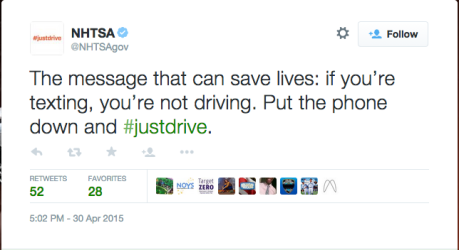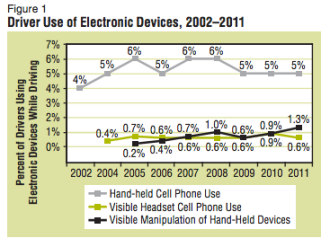photo from http://www.distraction.gov
Distracted Driving-A National epidemic from Madison Marcus on Vimeo.
Incidences of texting and driving have risen significantly across the country in recent years, data shows. So significantly, some even call it an epidemic.
The United States Department of Transportation launched a campaign back in 2009 with a mission to end distracted driving. Distraction.gov was created also in 2009 to supplement the DOT’s campaign.
“Distracted driving is a dangerous epidemic on America’s roadways,” Distraction.gov says on their homepage. “In 2013, 3,154 were killed in distracted driving crashes.”
The website lists a number of things someone can do to distract themselves from driving a vehicle. However, the National Highway Traffic Safety Association counts text messaging while driving the worst distraction because texting draws in a driver’s manual, cognitive and visual attention.

According to a survey done by the NHTSA, 660,000 people use a cell phone at any given time while they’re behind the wheel. Virginia Tech Transportation Institute also conducted a study in 2013 on distracted driving and they found that looking down a cell phone doubles the risk of a car accident.
When looking further into the numbers, studies find that over 10 percent of drivers under the age of 20 who were involved in fatal crashes were reported to be driving distracted at the time of the accident. Distraction.gov’s main goal is to use facts about distracted driving paired with real-life stories from people involved in a distracted driving-related accident to raise awareness about the subject.
“We know that awareness is not a solution by itself,” Lori Millen, a marketing specialist at Distraction.gov, said.

Millen said she believes that texting and driving is more a selfish, behavioral thing. She said the NHTSA has been embedding more videos and messages into YouTube videos and other groups in order to target more younger people.
When brought down to a local perspective, Stony Brook University is taking some of the same steps the government is taking to thwart young drivers from using their cellphones while driving. The initiative the university has been taking is mainly headed by the campus police department.
The campus police have ticketed more drivers on campus so far this year than they have in the past two years. Assistant Chief of Police, Eric Olsen, said this is because officers have been deliberately trying harder to catch people using a cell phone while driving before they cause an accident on or around campus.
He said university police are trying to educate people away from the act and that the last option is enforcement. As of March 31 of this year, campus police have given out 12 summonses to distracted drivers. This time last year, only 7 summonses were given out.
Olsen said there have not been any deaths and few injuries caused by an act of distracted driving. The most severe accident occurred by Stony Brook Hospital when a pedestrian was struck by a vehicle and contracted a brain injury. In this case, the pedestrian was the one who was distracted and didn’t see the car at the cross walk.
“There are a higher percentage of people walking than driving,” Olsen said. “But driving is more dangerous.”
Along with raising awareness on distracted driving, campus police have also included distracted walking into the initiative as well. They have installed messages on the pavement to thwart walkers from walking and looking down at their phones. So far, there are two pavement messages on campus, one by the Life Sciences cross walk and one by Tabler Quad. Both signs send a short and sweet message to “LOOK!” before crossing the road.
There are also cell phone applications that campus police have been promoting to students. AT&T Drive Mode is one of the apps students can use to drive safer. The app automatically replies to any text messages that are sent to a cell phone user when they are driving and silences all phone notifications. The app even turns on as soon as a car is in motion.
Campus police are not alone in their efforts to combat distracted driving. Stony Brook’s Center for Community Engagement and Leadership offers a distracted driving curriculum to local high schools. The goal of the Center is to educate Long Island youth before they begin to drive so that the numbers of texting and driving incidents on the Island decrease.
The program is directed by Dr. Carlos Fidel who started teaching about distracted driving after some students suggested it to him. Within the center, Stony Brook doctors and professors put on a two-day lecture on distracted driving, complete with facts and statistics, videos and driving simulators, for these high school students.
“From the high school teachers, from what the students tell the high school teachers, I think it’s been successful,” Dr. Stephen Smith, a cardiology professor and member of the Center, said. “We’ve gotten a lot of letters and emails indicating the students continue to talk about it. They felt the presentation was great and they feel that it has made an impact.”
Dr. Smith has been participating in this program since it first started. He said the data on the program’s success has not yet been recorded to officially gauge the success of the distracted driving curriculum. The program mainly works with high-needs school districts around Long Island. So far, the Center has not done anything directly for the university.
“The whole idea behind the program is saving lives,” Smith said. “And it’s young people’s lives.”


